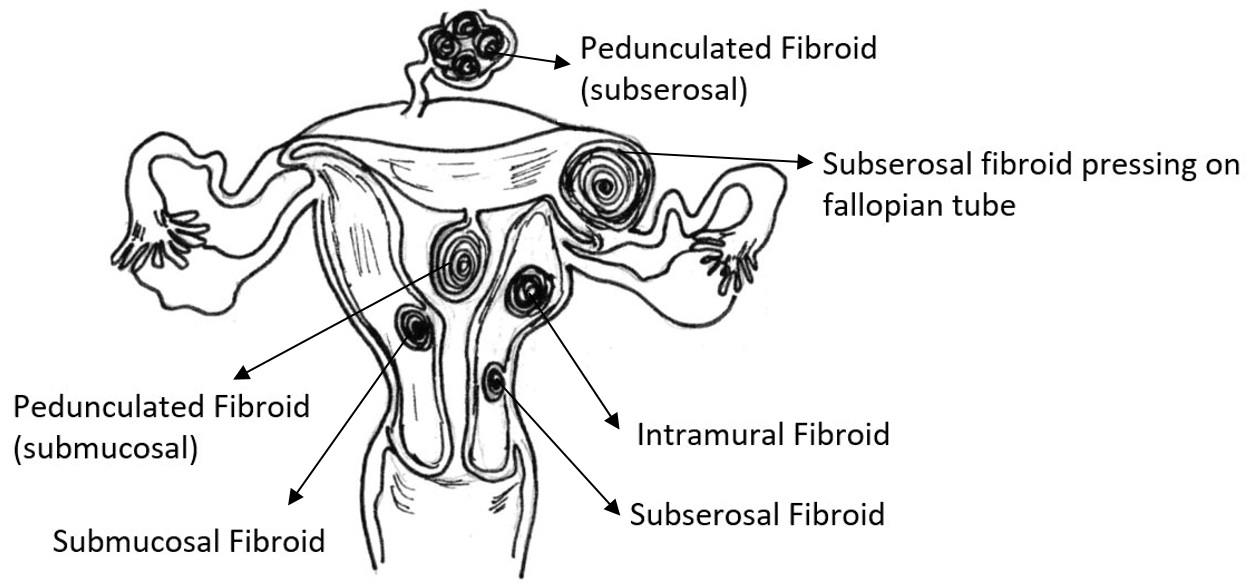Fibroid, or in other words ‘Leiomyoma’ or ‘Myoma’, is a common growth developed from the wall or muscle of the womb (uterus). Fibroid may occur in a form of solitary or multiple growths and it commonly occurs in reproductive age women. About 20% of reproductive age women have fibroid and rarely found in those who have not yet started menses. The growth usually shrinks after menopause.
There are several types of fibroid based on their locations:
- Submucosal fibroid – Fibroid that grows into the inner cavity of the uterus
- Intramural fibroid – Fibroid that grows within the muscular uterine wall
- Subserosal fibroid – Fibroid that projects outside the uterus
- Pedunculated fibroid – Fibroid that extend from the uterus on a stalk, which may be found extending outside the uterus into the pelvis or found within the inner uterine cavity extending through the cervix

Symptoms
Most of the women with fibroid do not have distinct symptoms. However, the symptoms depend on the size and the location of the fibroid and distance of the fibroid from the cervix. It may cause the following symptoms:
- Lower abdominal discomfort or pressure on the pelvis
- Pain or sore below the waist
- Menstrual pain (dysmenorrhoea)
- Abnormal vaginal bleeding
- Bleeding in between menstrual cycle (intermenstrual bleed)
- Prolonged menses
- Heavy menstrual flow (menorrhagia)
- Pain during sexual intercourse (if the fibroid is too large)
- Sensation of incomplete emptying of bladder or urinary frequency (due to the pressure on the urinary bladder)
- Constipation (due to the pressure on the rectum)
Complications
Approximately 3% of women with fibroid have difficulty to conceive. This is due to the presence of the fibroid which alter the uterine wall causing difficulty of the implantation of the embryo in the uterus. If the fibroid is too large, it will obstruct the fallopian tube causing difficulty in conceiving. Other complication is anaemia resulted from heavy menses.
Fibroid in pregnancy will cause pain and pressure to the pelvis which may lead to premature labour.
Treatment
Majority of patients with fibroid do not require treatment unless they have significant symptoms causing problems to them. If your fibroid is small and does not cause any symptom, you may follow up every 6 to 12 months. Ultrasound scan is done during the follow up.
The doctor will usually give advice according to: 1) seriousness of pain and heavy menstrual flow, 2) rapidly growing fibroid and large fibroid, 3) age and 4) desire of the patient to get pregnant
Choices of treatment include:
- Hysterectomy – surgical removal of the uterus. Hysterectomy is the best choice if the patient has completed family size. It is also the best choice because the fibroid is avoided permanently. Consequently, you will not be able to conceive and become menopause.
- Myomectomy – surgical removal of the fibroid from the uterus. The uterus is left in place. There is possibility of recurrence of the fibroid (within 10 years) with this method. Nevertheless, you are able to conceive.
- Endometrial ablation can be used for growing fibroid in the inner uterus. The inner layer of the uterus (endometrium) is removed using laser, heated wire loop, or microwave ablation using a balloon
- Uterine artery embolization – a non-surgical procedure to shrink the uterus by blocking off their blood supply
- Medication – it is used to treat symptom. The medication reduces the oestrogen level temporarily and retards the fibroid growth and commonly used before surgery. However, this medication may cause menopausal symptoms such as hot flushes, vaginal dryness and bone mass reduction. The treatment is usually given for 3 to 6 months. The fibroid will grow again after stopping the hormonal treatment.
Prevention
The exact cause of fibroid is uknown, but the experts believe that fibroid may be related to genetic, hormone and surrounding environment. Unfortunately, there is no known way to prevent fibroid from growing or recur.
Rehabilitation
Various ways to reduce the discomfort caused by fibroid:
- Painkiller to reduce pain
- Bed rest when the symptoms get worse
- Intake of high iron food (such as red lean meat and spinach) and iron pills (supplement) to avoid anaemia caused by heavy menses
- Warm compression at the abdomen using bottle filled with warm water and hot water bath to reduce pain.
- Exercise such as sit up
- Drink plenty of warm water and reduce intake of carbonated drinks and cold water
- Practice self-hygiene, frequent change of sanitary napkin if soaked
Support group/ References
http://www.obgyn.net/ah/images/types_of_fibroids.jpg
http://www.hopeforfibroids.org/missionstatement.html
http://www.fibroidnetworkonline.com/
http://groups.yahoo.com/group/uterinefibroids
| Last Reviewed | : | 23 August 2019 |
| Writer | : | Dr. Anizah Aishah Rosli |
| Translator | : | Dr. Nor Faizah bt. Ghazali |
| Accreditor | : | Dr. Hj. Mohamed Hatta bin Mohamed Tarmizi |
| Reviewer | : | Dr. Rafaie bin Amin |







